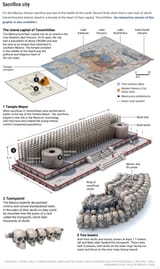Search Results
7/24/2025, 8:11:27 AM
>>716289083
>>716282325
>and not all Nahua states were actually inside that "Empire"...
Cont:
In general it's best to think of the Aztec Empire more of a network of different states, some of which were subjects, or voluntary vassals, or allies or one another, and just at the top of the network it all eventually led to Tenochtitlan and/or Texcoco and Tlalcopan (If they were collective capitals with Teno. just with the most power; if Teno. was a singular true capital, or if it's really 3 separate but intertwined "empires" is kinda debated)
Anyways, Tenochtitlan probably sacrificed a few hundred to a few thousand people a year (def not tens of thousands), based on the Great Skull Rack excavations (pic). Other cities and towns probably did many times less, but for both/all there's a lot of wiggle room
The rest of what you posted is mostly right: I'd nitpick and say the skull racks and towers weren't "just" skulls in that they also had mortar, stone, wooden poles, etc, and that I'm not quite sure about your exact description of the typical afterlife: Not all people went through Mictlan's layers and desu I get the layers mixed up with the ones from the Maya underworld. Ritual cannibalism was also a broader thing then just for Xochiquetzal, and I'm not familiar with cave sacrifices/burials to Tezcatlipoca
The big issues and nitpicks I already commented on aside, the greentext is just cherrypicked. You could make a similarly hardcore reading of Roman or Chinese society, or I could cherrypick a greentext that just talks about their amazing sanitation standards, great aqueducts and waterworks, lavish palaces, botanical gardens, venice-like canals, the value they placed on poetry and the arts and sciences, their judicial systems, how much they cherished their children and how even the Spanish praised and respected all of that and even their moral ethics and virtues: All of that info would be CORRECT, but I'd be excluding info about sacrifices, warfare, classism etc
11/?
>>716282325
>and not all Nahua states were actually inside that "Empire"...
Cont:
In general it's best to think of the Aztec Empire more of a network of different states, some of which were subjects, or voluntary vassals, or allies or one another, and just at the top of the network it all eventually led to Tenochtitlan and/or Texcoco and Tlalcopan (If they were collective capitals with Teno. just with the most power; if Teno. was a singular true capital, or if it's really 3 separate but intertwined "empires" is kinda debated)
Anyways, Tenochtitlan probably sacrificed a few hundred to a few thousand people a year (def not tens of thousands), based on the Great Skull Rack excavations (pic). Other cities and towns probably did many times less, but for both/all there's a lot of wiggle room
The rest of what you posted is mostly right: I'd nitpick and say the skull racks and towers weren't "just" skulls in that they also had mortar, stone, wooden poles, etc, and that I'm not quite sure about your exact description of the typical afterlife: Not all people went through Mictlan's layers and desu I get the layers mixed up with the ones from the Maya underworld. Ritual cannibalism was also a broader thing then just for Xochiquetzal, and I'm not familiar with cave sacrifices/burials to Tezcatlipoca
The big issues and nitpicks I already commented on aside, the greentext is just cherrypicked. You could make a similarly hardcore reading of Roman or Chinese society, or I could cherrypick a greentext that just talks about their amazing sanitation standards, great aqueducts and waterworks, lavish palaces, botanical gardens, venice-like canals, the value they placed on poetry and the arts and sciences, their judicial systems, how much they cherished their children and how even the Spanish praised and respected all of that and even their moral ethics and virtues: All of that info would be CORRECT, but I'd be excluding info about sacrifices, warfare, classism etc
11/?
Page 1
